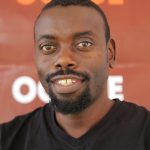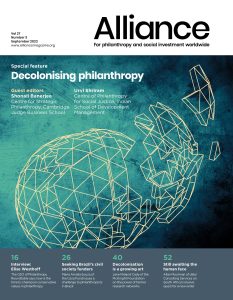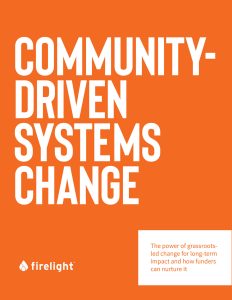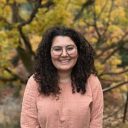The Firelight Foundation has been pioneering a community-driven systems change (CDSC) approach to its work with children and young people in Southern and Eastern Africa. What is distinctive about CSDC and what is it achieving?
Alliance members voted to find out more, so Digital Editor Elika Roohi talked to Firelight’s Learning and Evaluation Officer, Ronald Kimambo and to some of Firelight’s grantee partners: Joseph Jackson of the Organisation for Community Development in Tanzania, Michael Sumani from Tikondwe Community-Based Organisation in Malawi and Margaret Mundia of the Wise Trust in Zambia.

Community-Driven Systems Change lets grassroots communities dictate their own path. Photo credit: Shutterstock
Elika Roohi: Could you tell us about the work of your different organisations?
Margaret Mundia: Wise Trust is a CBO founded in 2002 and focuses on women and children so that they can realise their full potential.

Michael Sumani, Tikondwe Community-Based Organisation, Malawi
Michael Sumani: We focus on four major programme areas: women and children, youth development, care and support, and climate conservation interventions. The community itself decided to establish the CBO in 2000 to combat some of the problems it was facing.
Everyone in the community participates in the process.
Joseph Jackson: OCODE, or the Organisation for Community Development, is a grassroots national organisation that works to improve the lives of marginalised groups, particularly children, youth and women. We work with the community, the government and other stakeholders to ensure that children have access to quality primary education. We work with adolescents who have either dropped out of or could not access the formal education system, and we help equip them with life skills and vocational skills. For women, we mobilise the parents of the children to pool their resources and lend to each other in order to start or expand income-generating activities.
Ronald Kimambo: Firelight is a donor fund that works with community-based organisations in eastern and southern parts of Africa, whose main focus is on children and youth. We support them with funds and technical assistance to be able to identify the key issues facing children and youth in their communities and to work with various community stakeholders to come up with community actions to address their root causes.
ER: What does community-driven systems change mean to each of you?
MS: Community-driven systems change means the communities themselves are at the centre, identifying the root causes of the problems and finding solutions.

Joseph Jackson, Organization for Community Development, Tanzania
JJ: For us, it’s where the community are active participants in the process of addressing the challenges that they face.
MM: Community-driven systems change is when the community focuses on addressing issues as a team employing justice and solidarity.
ER: How does the Firelight Foundation identify organisations that are doing this kind of work?
RK: First of all, we establish a rapport with various stakeholders including the relevant government ministry, local governments, civil society, organisations, and networks within those particular areas, and try to explore various community-based organisations in the area that are recognised as having legitimacy in the community and are implementing community-driven approaches. We go and meet and talk to them, then we reflect together with the stakeholders that have been part of the process, and then identify internally which particular community-based organisations we’d like to support. We ask them whether they would like to join us. We don’t assume that because we are a funder they will be ready to work with us. We want to explore whether they’d like to come together in this particular partnership and for them to have an opportunity to say yes or no. So we are really using an approach, as Margaret highlighted, of justice or solidarity.
ER: How does the community-driven systems change approach compare with being told what you have to do by donors or international NGOs?
MS: For me and my colleagues, it’s exciting to be part of implementing this approach. We find it very successful and powerful because not only does it have a better chance of being sustainable, but it cuts out the issue of dependence syndrome among the community.

Margaret Mundia, Wise Trust, Zambia
MM: Before, funders would impose a programme, and community members and direct beneficiaries had no say, even when they realised there were gaps. When the donors left, the whole system was paralysed.
We always urge our partners to make it clear to other stakeholders that they are not there to replace communities and they’re not there to replace governments – they are there to facilitate the process of bringing development and social transformation.
JJ: We found that addressing problems is not a straight linear process because getting to the root cause asks so many difficult questions and because it involves different stakeholders and power dynamics, it takes time to come together and requires commitment and resources. So I would stress that it’s a learning process, a challenging process to ensure that you address the leading cause of the problem.
ER: Ronald, how has this experience of developing the CDSC approach been from the funding side?

Ronald Kimambo, Firelight Foundation, Tanzania
RK: I agree: it’s a messy process as Joseph said, and there is a lot of going back to the drawing board because communities, who are the priority, are dynamic things. Due to Covid-19, for instance, we had to pause our plans because communities had more immediate needs and we wanted to support them to fight the pandemic. Other restrictions too, like no gatherings, masking, travel bans, all delayed implementation of the programme, and you have to understand that you cannot come in and disregard what communities are facing simply because you have a certain work plan or timetable. You need to be highly responsive, constantly test things, listen to the communities and grantee partners, and refine what you need. It’s quite different from more paternalistic approaches. Secondly, as someone else mentioned, CDSC reduces dependence. The CBOs need to understand this is a time-limited – three or four years – initiative but the CBO will remain, so how can they capitalise on their resources within the timespan of the initiative to make sure that they are really creating a foundation for communities to be more self-sustaining? We always urge our partners to make it clear to other stakeholders that they are not there to replace communities and they’re not there to replace governments – they are there to facilitate the process of bringing development and social transformation.
ER: How does the CDSC approach make a difference in addressing systemic issues affecting children and young people?
MS: The approach is very holistic. When we were doing a project on ending child marriage, for instance, the children themselves were in the focus group discussions to brainstorm some of the issues and ways of addressing them. Everyone in the community participates in the process.
JJ: The approach makes a big, big difference. When you go into a community, you see the problem and often you are tempted to jump to a quick solution. For example, there are no classrooms, so you build classrooms. It’s a quick-fix solution. But when you bring the stakeholders together, a lot of issues come out and you might find that a classroom is not really the problem – it’s that children are not going to school for some other reason. So you dig deep into the process and you find that all the stakeholders bring in a different understanding of the issues, then you discuss them and come up with a different solution. The main issue here is the sustainability of the change that all of you together bring. Using this approach. sustainability is guaranteed because they all know why this is being done.
MM: This CDSC approach has helped improve the nutrition of children. The mothers, too, have improved health status and young people are able to make healthy choices.
The grantee partners we select are born and raised in the community and they have community legitimacy, but sometimes they are left out when it comes to funding, so listening to them will really decolonise the philanthropy process.
RK: Just to add to what colleagues have mentioned, there’s a huge difference because, in this process, community-based organisations map out systems and underlying root causes before coming up with any action. Take the example of child marriage, this mapping can identify the root cause of why there are so many cases of child marriage and pregnancy. It might be the absence of community by-laws protecting girls, or it might be the lack of enforcement of those by-laws by traditional leaders, so chiefs or traditional leaders can then be engaged to make sure that they understand the gravity of the problem, or to see what else is missing. Through the CDOs’ engagement with other players within the ecosystem, they are able to change the narratives in particular ways.

A quarterly review for community stakeholders to consult on the progress made on ending child marriage. Photo courtesy of Tikondwe Community-Based Organisation
MS: CDSC has made a difference. Because of the by-laws, community leaders are able to identify that child marriage is an issue and are able to handle cases of it. Since the start of our programme, chiefs have terminated around 25 child marriages because the by-laws help them. They make referrals to relevant stakeholders where the situation requires it, so we are seeing a great difference in the communities. They are also establishing committees in each village to identify problems that affect the children, many to do with child marriage. So CDSC has made a great difference. The number of cases is decreasing because communities have realised that child marriage is an evil.
RK: To supplement what Michael says, when the initiative started around 2020, there were more than 1,000 cases of child marriage and pregnancy, but the government department responsible was not aware of them. The perpetrators know it’s illegal in Malawi, so they keep it secret and, if you are a government official, it’s difficult for you to be able to pick that up without having someone who’s really connected to these communities to inform you. The CBOs involved are very grassroots structures with their ear to the ground and can alert government officials or child protection workers. As the result, when we visited them earlier this year, the number of cases had dropped to ten.

Read Alliance’s issue on Decolonising philanthropy
ER: Alliance magazine’s September issue focused on decolonising philanthropy. How does funding CDSC advance decolonising philanthropy?
JJ: The approach gives an active role to those facing the problem. In most cases, you find that the problem the community needs to address has already been defined by the donor. Firelight, who we have worked with for over seven years, gives an opportunity to community organisations to be able to define the problem and to mobilise their communities to address it and they build the capacities of these organisations to do that, so the CDSC approach can contribute to the power shift in philanthropy. As with the example of child marriages which we’ve heard about, there is a policy in place but child marriage continues because the community was not involved in forming that policy. Where organisations are making resources available to community organisations, people at the grassroots are active participants in the process. There are power dynamics between the funding organisation and the receiving organisation and we need to harmonise these which community-driven system change does.
Achieving meaningful change requires time, so there is a need to shift from shorter- to longer-term funding of the development process.
RK: The grantee partners we select are born and raised in the community and they have community legitimacy, but sometimes they are left out when it comes to funding, so listening to them will really decolonise the philanthropy process. In designing initiatives, we must start with resources that will really help map out the systems and understand the underlying causes, so that we are not just scratching the surface but diagnosing the real disease, and prescribing the correct remedy. Also, you want them to be independent so you have to allocate resources to strengthen these organisations and their communities. When it comes to learning and evaluation, for instance, you have to help them identify what success and effectiveness mean in their context. How do you make sure the process is participatory? There’s nothing for them without them in this process. They need to be able to define the parameters of change, they need to determine what to measure, and they need to put in place a matrix that will really help them to track whether they are really making progress towards that change. Those are some of the aspects of CDSC, and once funding is supporting CDSC as an approach, it will really advance decolonisation.
JJ: To add to what Ronald just said, we are several different organisations but funders often come up with a one-size-fits-all solution to various challenges that we face, but the Firelight Foundation, in working to build our capacities, allowed us to propose how we want that to be done. I’ll take monitoring, evaluation and learning as an example. Their original plan was for us all to be trained together but because we as an organisation knew where we wanted to go, we said no. Maybe you can help us find a consultant to work with us on our systems, but we do what we call learning by doing. And Firelight believed in us as an organisation to know what exactly we needed and they helped us develop the method and the models that we wanted to implement. So the role of the funder is to support an organisation in terms of capacity building, but it should be a shared vision where you analyse together and you have trust in each other to make it work.
MS: Our CBO was just a small organisation, so CDSC has been great in allowing us to demand what we want in terms of capacity building. For instance, recently we had a meeting with Firelight Foundation officers, where we requested capacity building in different areas – monitoring and evaluation, proposal development, and strategic planning – this has been crucial in helping us become sustainable.
ER: What do you want funders to understand about the CDSC approach?
MS: This tool starts from the communities. The days are gone when donors supported communities without listening to them. The CDSC approach makes it more likely that the project will be sustainable and will bring change to the communities.

Group counselling on the effects of child marriage. Photo courtesy of Tikondwe Community-Based Organisation
JJ: Achieving meaningful change requires time, so there is a need to shift from shorter- to longer-term funding of the development process. But it also requires trust and commitment. If you don’t trust each other, it becomes difficult to work.
RK: Funders should understand that the CDSC approach is a messy process. There’s nothing straightforward, from the identification of CBOs, self-indicators, activities or stakeholder engagement to results measurements. There’s a lot of learning along the way which sometimes involves being ready to go back to the drawing board. The first year of implementation is basically a learning and planning phase. All stakeholders will need patience and time.
ER: What would you say to funders who argue that it’s too difficult for them to adopt this approach?
MS: What donors need to know is that with CDSC, we are trying to migrate from just providing money to the communities, to giving them the skills they need to resolve their own problems. So though it’s difficult, it’s important to support this approach.
JJ: Of course, some funders might find this approach challenging because different organisations define success differently. I would suggest that the main funders use intermediary grantmakers who might be better suited to prepare the ground before the main funder comes in.

Firelight Foundation’s toolkit on Community-Driven Systems Change
ER: Firelight Foundation has put together a CBSC toolkit. Where would you want funders to start with that toolkit, and what should be their number one priority?
RK: Maybe the tool for designing a new CDSC initiative. The priority should be understanding how to design an initiative that supports the CDSC approach and also adjusting their grantmaking to support community-driven system change.
ER: Michael, Joseph, Margaret, could you share how you’ve used the toolkit in your own work?
MM: In empowering the community to drive positive change, mobilising community, advocacy and sensitisation meetings are also needed. I think this is where the funders should be respectful.
JJ: The initial stage – how do you get to know each other? – is fundamental in building trust because one of the challenges of the work we are doing is trust.
ER: Any final thoughts?
RK: When we were trying to convince our board, one of the critical questions that they asked was about the genuineness of the CDSC approach. We are an intermediary funder at Firelight and if our main funder’s priority was ending child marriage, what if the communities had a different priority? Is it a true CDSC in that case? We had to convince our board that whilst their concerns were valid, we do not prescribe to the communities what to focus on within the areas chosen by the funder. CBOs have the opportunity to engage their communities to surface the root causes and prioritise issues as well. So, we consider our initial parameters as entry points and CBOs and their communities can come with their own community’s long-term visions and understanding. Firelight is only one stakeholder, and there are many others within the ecosystem who could contribute to realisation of their community’s vision. We have conducted a multi-country study in Tanzania, Zambia and Malawi that seeks to map out areas of need and opportunity for community action on the rights and well-being of children and we are disseminating this to funders so that they can choose from the issues surfaced by the communities. And in terms of challenges that funders should expect, most stakeholders are used to traditional funding approaches, and it will take some time to manage expectations and get grantees to feel confident to take the driver’s seat and funders should allow themselves to be vulnerable with grantee partners, for instance, sharing information such as the total funding that they will provide. Their partners should also be allowed to push back and question funders, including their systems, approaches and tools and allow time to co-create with grantee partners which means they may end up funding activities that are not their idea, but those that are determined by the community. And when funders say the CDSC approach is too difficult, we’d tell them that yes, it’s difficult, but it’s the genuine way to support communities in a way that responds to community needs, the way to shift power to where it really matters. They need to be prepared to change a lot of the systems and processes as well, such as grantmaking templates to align with this approach. They also need to think about the end goal. These communities may have a vision that will be realised after 20 or 30 years and this initiative that we support is only for three or four years so it’s important to really embrace communities and CBO or grantee partners’ ideas.
MM: The community-driven system change approach is very viable in the sense that it has stimulated active participation in both CBOs and the community we are working in. By the time Firelight’s support ceases, we will have learned a lot.
 This piece was produced as a part of the Alliance membership programme. Alliance members shape the global conversation on philanthropy. Become a member today!
This piece was produced as a part of the Alliance membership programme. Alliance members shape the global conversation on philanthropy. Become a member today!






Comments (0)